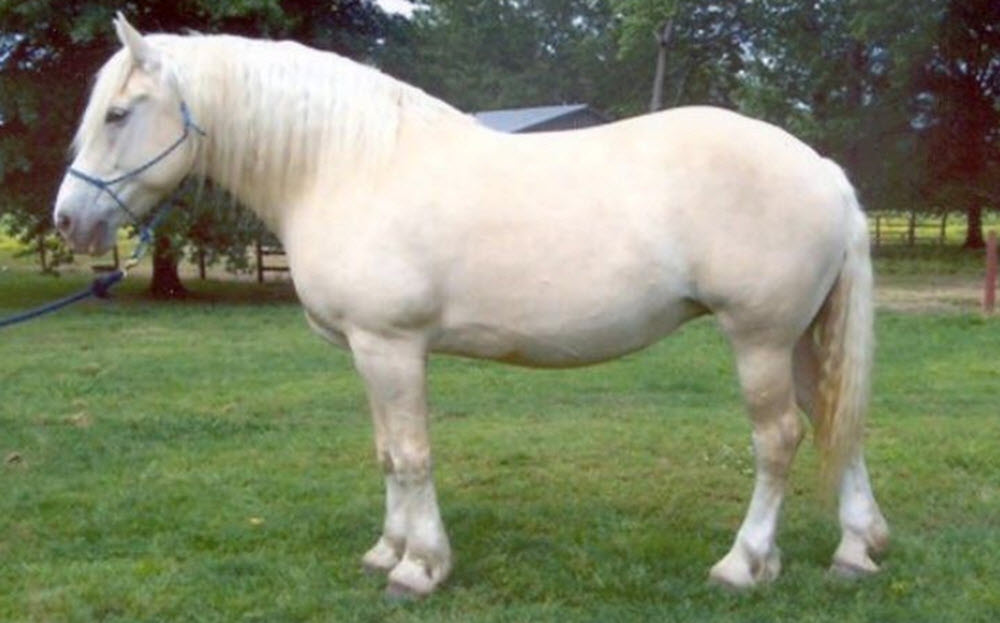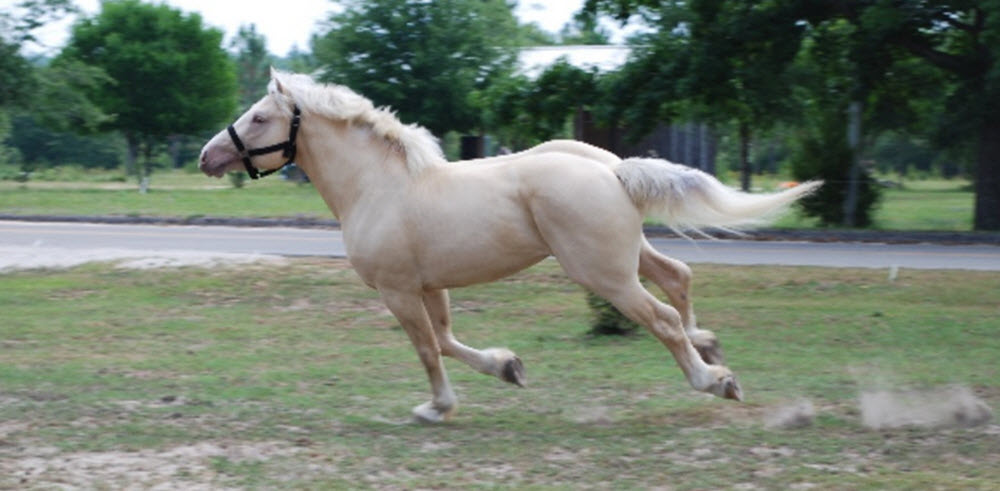On this page:
The American Cream Draft is a draft horse developed in the United States, distinguished by its creamy color (known as “gold champagne”), amber eyes and medium-heavy build. The particular coloration is produced by the actions of the champagne gene upon a chestnut base color.

The American Cream Draft descends from the cream-colored foundation mare Old Granny, who had pink skin and amber eyes. She was foaled in the early years of the 20th century and sold to the Nelson Brothers Farm in Iowa.
The mechanization of farming after WWII led to a general decrease in the need for horses on farms, and this had a major negative impact on the interest in the American Cream Draft. For several decades, the breed registry remained dormant, before it was revived again in 1982.
Today, the American Cream Draft is still a rare horse breed. Some of the most well-known remaining individuals are the ones who live in Colonial Williamsburg, a living-history museum in Virginia, United States. In the village, they are used for wagon and carriage rides.
The breed is renowned for its calmness and eagerness to please.
The American Cream Draft Association
The breed standard for American Cream Draft was created by the American Cream Draft Association 1944.
Characteristics
Movements
The American Cream Draft horse is characterized by sure-footedness and their movements are free and easy.
Height
Mares: 15-16 hands
Stallions and geldings: 16-16.3 hands
Weight
Mares: 1500 – 1600 lbs
Stallions and geldings: 1800 lbs or more
Body
- Refined head
- Flat facial profile; neither concave or convex
- Wide chest
- Sloping shoulders
- Well sprung ribs
- The back is short and strong, with well-muscled hindquarters
- The legs are strong, well-proportioned and set well apart
- Strong hooves
Color
The ideal American Cream Draft has:
- A medium cream coat, produced by the champagne gene
- Pink skin
- Amber eyes
- White mane and tail
Even though medium cream is the most desirable color, other cream colors are recognized as well, such as light cream and dark cream. Hazel eyes are permissible.
A mare who has a light mane and tail, and sports dark skin, may be accepted by the registry, but a stallion is only registered if he has pink skin and a white mane and tail.
A purebred American Cream Draft foal that is too dark for the main breed registry may be registered in the Appendix Registry. The Appendix Registry also registers half-breeds under certain conditions, if the non-ACD parent is a draft horse. Horses registered in the Appendix Registry have become an important tool for creating more diversified ACD bloodlines, strengthen the breed and getting the numbers up.

Health
Like several other draft horse breeds, the American Cream Draft has an increased risk for junctional epidermolysis bullosa, an autosomal recessive genetic disease known colloquially as red foot disease and hairless foal syndrome.
History
Old Granny
As mentioned above, the foundation mare for American Cream Draft was the cream-colored, pink-skinned and amber eyed Old Granny. We don’t know exactly which year she was born, but it was probably in the 1900-1905 span. In 1911, the stock dealer Harry Lakin noticed her at an auction in Story County, Iowa, and bought her. She was then sold to the Nelson Brothers Farm and moved to Jewell, Iowa.
Many of Old Granny’s foals had the same cream-color as their mother, and they fetched a premium price for their beauty.
Silver Lace No. 9
One of the most influential stallions for the American Cream Draft breed was Silver Lace No. 9. He was a great-great-grandson of Nelson’s Buck No. 2, who in turn was foaled by Old Granny in 1920. Nelson’s Buck No. 2 sired several cream-colored foals, including a colt named Yancy No. 3, foaled by a black Percheron mare. Yancy No. 3 sired Knox 1st (born in 1926) with a mare of mixed Shire ancestry. From that line, Silver Lace No. 9 was foaled in 1931. His dam was a light chestnut Belgian mare.
Silver Lace No. 9 weighed 2,230 lbs – considerably more than what was standard for his bloodline at the time. He probably got this genetic disposition from his Belgian mother.
He was never registered with any breed registry, but became a very sought after stud anyway, especially in Iowa.
Ead’s Captain
Ead’s Captain is another example of a stallion that has had a great impact on the breed. Today, roughly one-third of all registered American Cream Drafts have Captain in their bloodline.
Breed registry and recognition
In the mid-1930s, several breeders started linebreeding and inbreeding cream-colored horses to fix their color and type. One notable force behind this was C.T. Rierson, who purchased several cream-colored mares sired by Silver Lace No. 9 and used them for breeding.
The breed registry for American Cream Draft was created in Iowa in 1944 by 20 owners of cream-colored draft horses. Two years later, 98% of its registered horses could be traced back to Old Granny.
The breed was recognized by the Iowa Department of Agriculture in 1950.
Decline
The proliferation of motorized vehicles in the United States led to a dramatically decreased need for draft horses. By the late 1950s, the American Cream registry contained no more then 200 living individuals.
The register eventually became inactive, until 1982 when three families reactivated it. By 2004, there were 350 registered horses, including 40 horses that only partially fulfilled the requirements and were registered as “tracking horses”.
